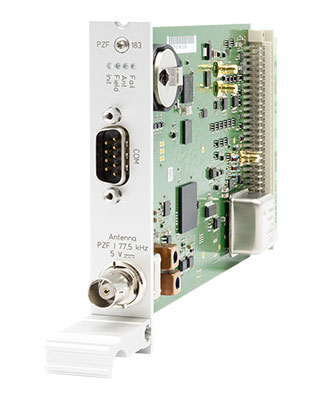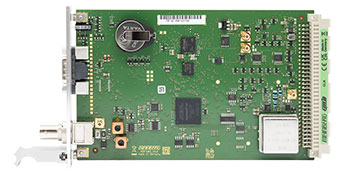IMS-PZF: PZF (DCF77) Correlation Receiver (Eurocard)
Key Features


- High accuracy DCF77 correlation receiver for generation of standard frequencies and pulses
Oscillator Options: OCXO-SQ, OCXO-HQ, OCXO-DHQ - Pulses per second and per minute
- RS-232 interface
Product Description
Functionality
The IMS-PZF receiver reads the current date and time from the DCF77 long-wave radio signal broadcast on 77.5 kHz. Once the PZF receiver is successfully synchronized with the long-wave reference signal, it generates a PPS (pulse-per-second) phase reference and a 10 MHz frequency reference. These PPS and 10 MHz references are then forwarded to the installed IMS modules to be either directly output or to serve as the basis for the generation of other output signals as required for a variety of applications. In addition, the IMS-PZF clock generates pulses per second (PPS), per minute (PPM) and IRIG time code signals.
By evaluating the pseudo-random sequence (PZF), which is part of the DCF77 signal in addition to the amplitude modulation, the PZF clock is capable to reproduce a time pattern in the range of microseconds. This allows generation of high precision pulses and an accurate adjustment of the main oscillator of the receiver.
Characteristics
| Receiver | Quadrature receiver for optimized evaluation of the DCF signals (amplitude and phase modulation)
Accuracy of pulse outputs: Time delay between two systems with max. distance of 50 km: typ. 20 µsec, max 50 µsec Time shift of successive pulses: max 1.5 µsec |
| Status Indicators |
|
| Type of Antenna | DCF77 outdoor antenna AW02 |
| Synchronization Time | 2–3 minutes, given good DCF77 reception |
| Frequency Outputs | Frequency Synthesizer for arbitrary frequencies between 0.125 Hz and 10 MHz, adjustable phase, output via external modules such as IMS-BPE modules |
| Pulse Outputs | Pulse per second (PPS) and pulse per minute (PPM). TTL level, pulse width: 200 msec |
| Accuracy of Pulse Outputs | Better than +/- 50 μsec after synchronization and 20 minutes of operation. |
| Interface | Single serial RS-232 interface |
| Serial Time String Output |
COM 0:
Baudrate: 300, 600, 1200, 2400, 4800, 9600, 19200 Baud Data Format: 7N2, 7E1, 7E2, 7O1, 7O2, 8E1, 8N1, 8N2, 8O1 Time telegram: Meinberg Standard Time String , SAT, Uni Erlangen (NTP), COMPUTIME, SPA, RACAL, ION or Capture String |
| Switch outputs | Four TTL outputs can configured independently for the following modes: - free programmable cyclic or fixed impulses - timecode - timer mode; three 'ON'- and three 'OFF'-states can be setup per day The switch states can be inverted for all three outputs, the impulse lengths are configurable. The impulse output can be configured for all channels together to 'always' or 'ifsync'. |
| Supported Timecode Formats |
IRIG B002: 100pps, DCLS signal, no carrier, BCD time-of-year IRIG B122: 100pps, AM sine wave signal, 1 kHz carrier, BCD time-of-year IRIG B003: 100pps, DCLS signal, no carrier, BCD time-of-year, SBS time-of-day IRIG B123: 100pps, AM sine wave signal, 1kHz carrier, BCD time-of-year, SBS time-of-day IRIG B006: 100 pps, DCLS Signal, no carrier, BCD time-of-year, year IRIG B126: 100 pps, AM sine wave signal, 1 kHz carrier frequency, BCD time-of-year, Year IRIG B007: 100 pps, DCLS Signal, no carrier, BCD time-of-year, year, SBS time-of-day IRIG B127: 100 pps, AM sine wave signal, 1 kHz carrier frequency, BCD time-of-year, year, SBS time-of-day IEEE1344: Code according to IEEE1344-1995, 100pps, AM sine-wave signal, 1kHz carrier, BCD time-of-year, SBS time-of-day, IEEE1344 expansion for date, time zone, daylight saving and leap second in Control Functions segment C37.118: Like IEEE1344 - with inverted sign bit for UTC offset AFNOR: Code according to NFS-87500, 100pps, AM sine-wave signal, 1kHz carrier, BCD time-of-year, complete date, SBS time-of-day |
| Antenna Connector | BNC connector |
| Backup Battery Type |
CR2032 (lithium button cell)
In the event of loss of power to the main system, this battery powers the real-time clock and also ensures that GNSS almanac data is properly buffered in RAM. Lifetime of lithium battery: Min. 10 years |
| Cable Type | Coaxial cable RG58 indoor or outdoor usage (BNC-, N-Norm-connector) |
| Operating Voltage | +5 V DC |
| Current Draw | +5 V 1,1 A to 1,4 A (depends on oscillator option) |
| Supported Temperature | Operational: 0 - 50 °C (32 - 122 °F)
Storage: -20 - 70 °C (-4 - 158 °F) |
| Supported Humidity | Max. 85 % (non-condensing) at 40 °C |
| Warranty | Three-year warranty |
| Options | Synthesizer 1/8 Hz up to 10 MHz (TTL level, sine wave 1.5Veff, open drain) 4 programmable TTL outputs and timecode generator (IRIG-B, AFNOR) |
| RoHS Status of Product | This product is fully RoHS-compliant. |
| WEEE Status of Product | This product is handled as a B2B (Business to Business) category product. To ensure that the product is disposed of in a WEEE-compliant fashion, it can be returned to the manufacturer. Any transportation expenses for returning this product (at end-of-life) must be covered by the end user, while Meinberg will bear the costs for the waste disposal itself. |
Downloads
Data Sheet
Short Info Sheet
Manuals
- Handbuch (deutsch) ims-pzf-receiver.pdf als PDF: 1616KB - Stand: 31.Jan.2020
- Handbuch (deutsch) ims-pzf182_sug.pdf als PDF: 6452KB - Stand: 01.Oct.2024
- Handbuch (deutsch) ims-pzf183_sug.pdf als PDF: 6505KB - Stand: 25.Mar.2025
- Manual (english) ims-pzf-receiver.pdf as PDF: 1597KB - Rev.: 2020-Jan-31
- Manual (english) ims-pzf182_sug.pdf as PDF: 6430KB - Rev.: 2024-Oct-01
- Manual (english) ims-pzf183_sug.pdf as PDF: 6483KB - Rev.: 2025-Mar-25
- For drivers, SDKs, tools and utilities, please check our Download Section





